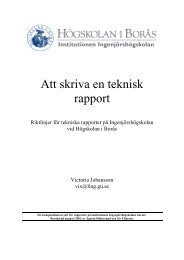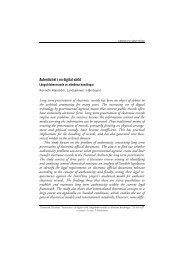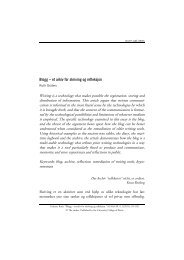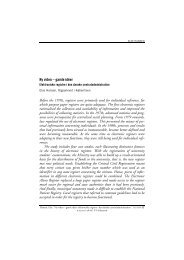The Challenge of Managing Affordances in Computer Game Play
The Challenge of Managing Affordances in Computer Game Play
The Challenge of Managing Affordances in Computer Game Play
You also want an ePaper? Increase the reach of your titles
YUMPU automatically turns print PDFs into web optimized ePapers that Google loves.
HUMAN IT REFEREED SECTION<br />
door simply as “can be opened”. None <strong>of</strong> these perceptions, though, are<br />
real affordances <strong>of</strong> the door, s<strong>in</strong>ce no matter how skilled a player becomes<br />
at controll<strong>in</strong>g her game pad, no matter how much <strong>of</strong> a pr<strong>of</strong>essional<br />
vision she develops, she will never ever pick up the affordance<br />
“‘open-able’ by press<strong>in</strong>g a button on the control”. <strong>The</strong>re is absolutely<br />
noth<strong>in</strong>g <strong>in</strong> the game or <strong>in</strong> the game environment that tells the player<br />
“you can open a door by click<strong>in</strong>g button x” for the simple reason that<br />
there is no such affordance – not on the screen, not <strong>in</strong> the virtual room,<br />
not on the virtual door itself, and not on the game equipment. <strong>The</strong> action<br />
<strong>of</strong> open<strong>in</strong>g a door has to be learned by means other than can be<br />
picked up on the screen. And it is here that pr<strong>of</strong>essional vision comes <strong>in</strong>to<br />
play.<br />
Pr<strong>of</strong>essional vision is, as Goodw<strong>in</strong> says, “socially organized ways <strong>of</strong> see<strong>in</strong>g<br />
and understand<strong>in</strong>g events that are answerable to the dist<strong>in</strong>ctive <strong>in</strong>terests<br />
<strong>of</strong> a particular social group” (1994, 606, emphasis added). Goodw<strong>in</strong>'s<br />
f<strong>in</strong>d<strong>in</strong>gs are based on studies <strong>of</strong> archaeologists and their practice <strong>of</strong><br />
cod<strong>in</strong>g schemes to categorise events relevant to their work, their practice <strong>of</strong><br />
highlight<strong>in</strong>g specific phenomena <strong>in</strong> their environment for better visibility,<br />
as well as their production and articulation <strong>of</strong> material representations, such<br />
as archaeological maps. <strong>The</strong>se practices are, accord<strong>in</strong>g to Goodw<strong>in</strong>, embedded<br />
with<strong>in</strong> webs <strong>of</strong> socially articulated discourses, i.e., the ability to<br />
see relevant objects or events is not the result <strong>of</strong> the <strong>in</strong>dividual m<strong>in</strong>d alone,<br />
but arises with<strong>in</strong> a “community <strong>of</strong> competent practitioners” (626).<br />
Follow<strong>in</strong>g this l<strong>in</strong>e <strong>of</strong> reason<strong>in</strong>g, the development <strong>of</strong> pr<strong>of</strong>essional vision<br />
<strong>in</strong> game play is, <strong>in</strong> other words, a social process <strong>in</strong> which players<br />
learn through “socially articulated discourse”, with<strong>in</strong> the community <strong>of</strong><br />
(competent) game play practitioners, what a game pad is for, how it can be<br />
used, and what <strong>in</strong>formation is relevant <strong>in</strong> different k<strong>in</strong>ds <strong>of</strong> game genres.<br />
Pr<strong>of</strong>essional vision has subsequently very little to do with the differentiation<br />
<strong>of</strong> “the <strong>in</strong>formation for a specific set <strong>of</strong> affordances which is relevant<br />
to a certa<strong>in</strong> group <strong>in</strong> a certa<strong>in</strong> situation” (L<strong>in</strong>deroth, L<strong>in</strong>dström and Bennerstedt<br />
2006, 4, emphasis added). Rather, affordances relevant to a certa<strong>in</strong><br />
group <strong>in</strong> a certa<strong>in</strong> situation entail from socially articulated discourses,<br />
i.e., they have been socially negotiated or agreed upon, or emerged implicitly<br />
among the group members (as social norms <strong>of</strong>ten do). In a sense,<br />
this is at odds with Gibson’s view on affordance – after all, an affordance<br />
100









